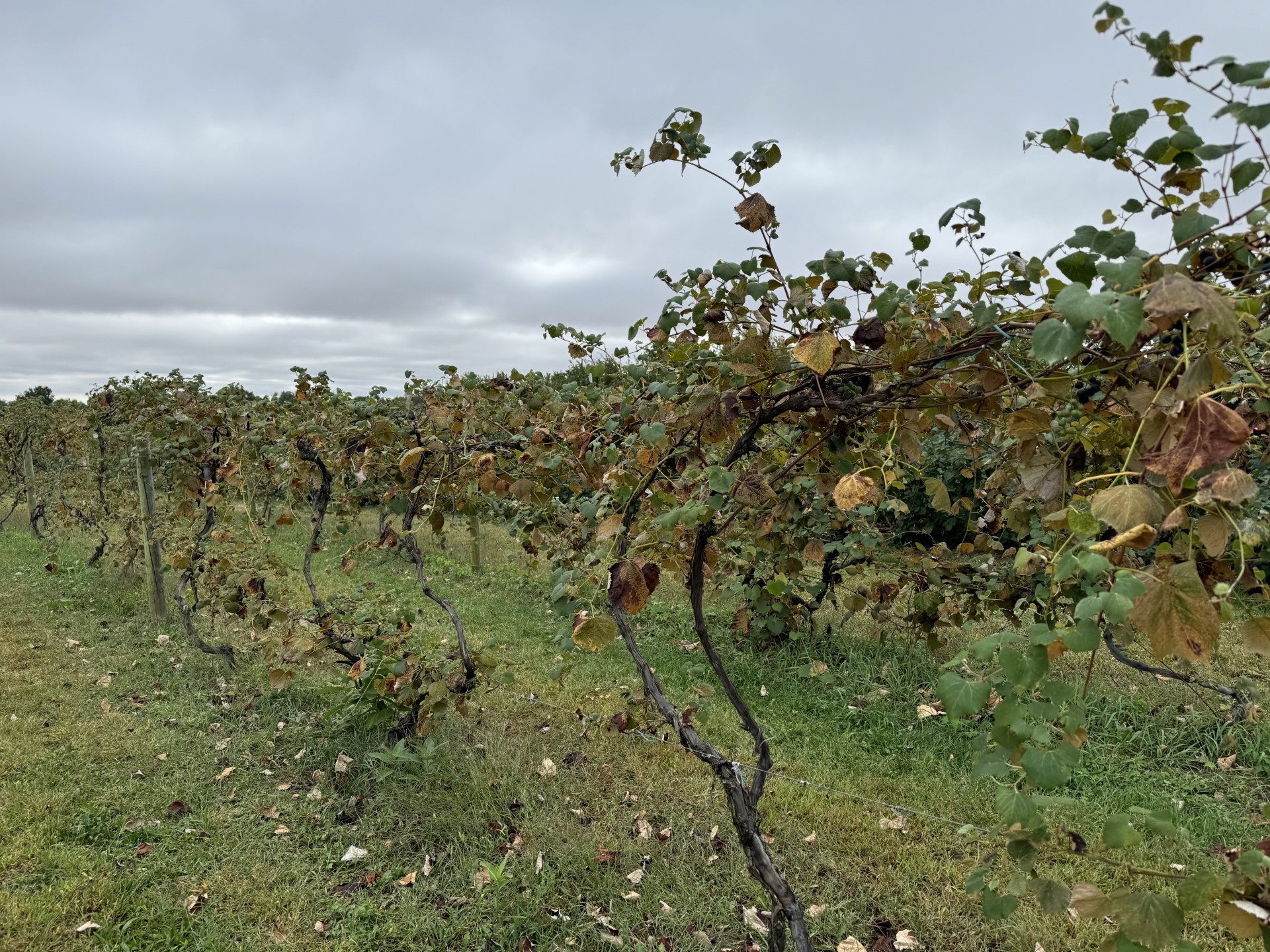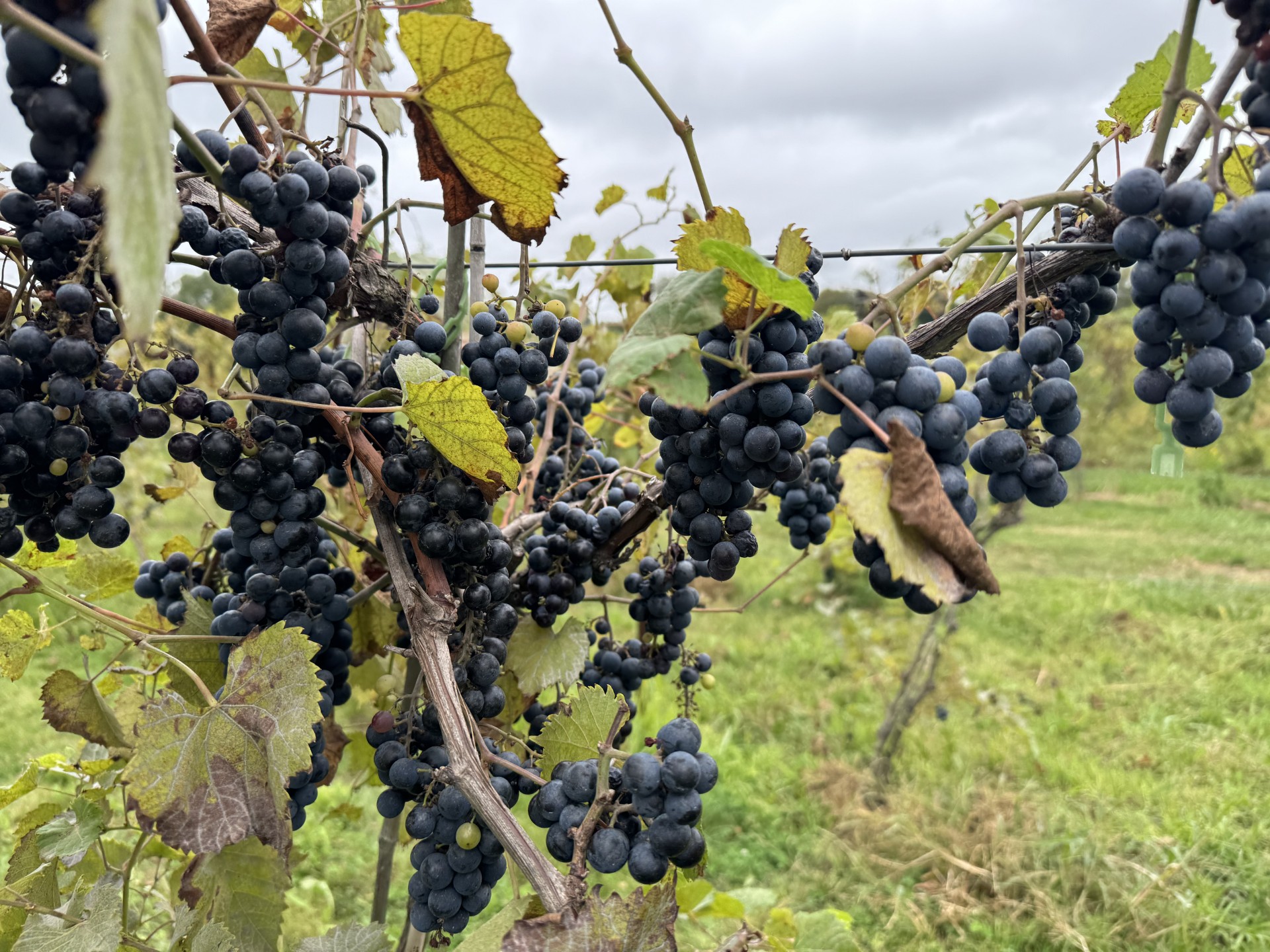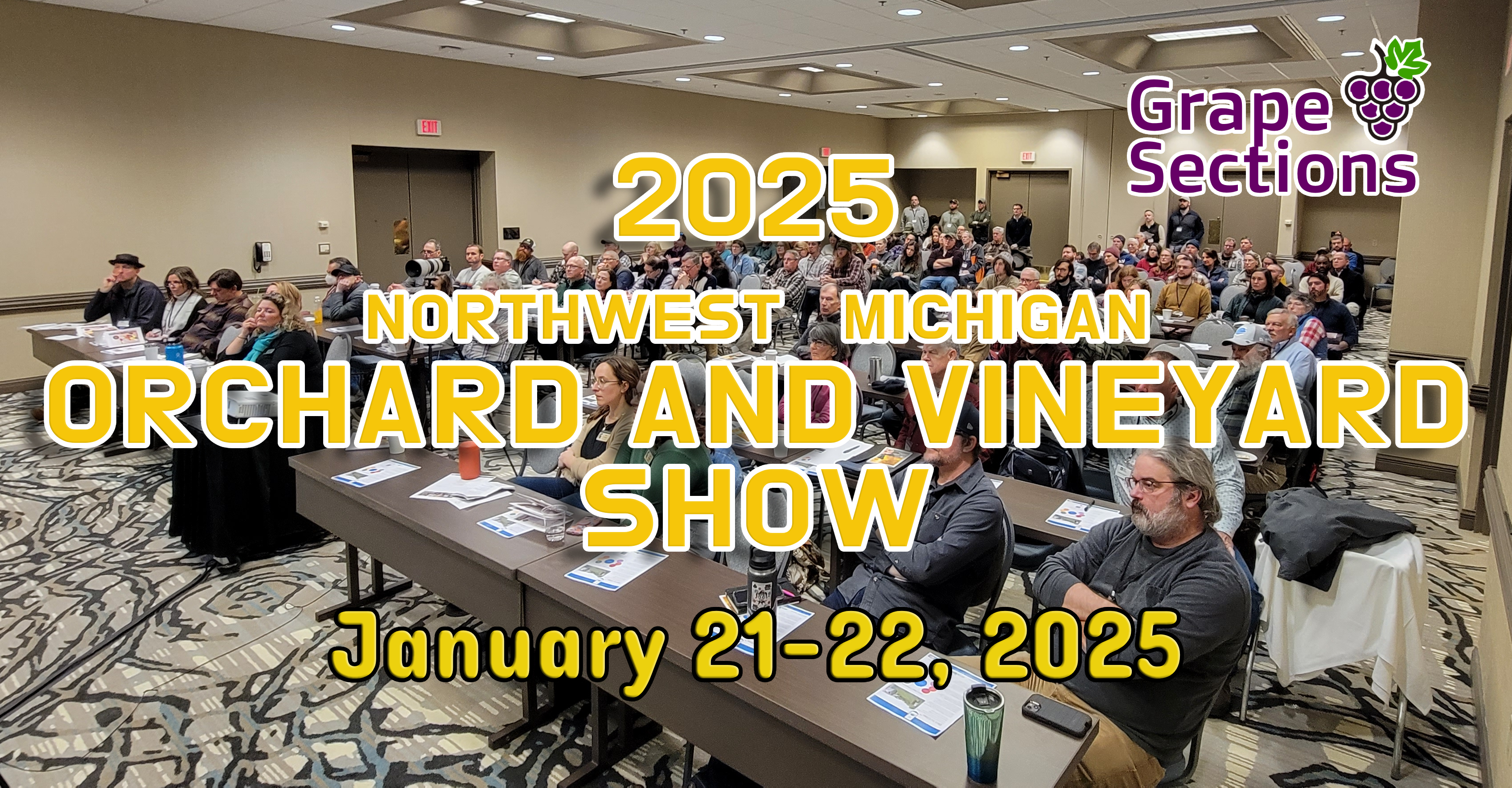Michigan grape scouting report – September 25, 2024
This year’s final report includes insights on vine growth, disease management, and weather forecasts to support your success. We wish you a successful harvest!

Thank you for staying connected with our weekly updates. We appreciate your commitment to improving grape growing in Michigan. This year’s final report includes insights on vine growth, disease management, and weather forecasts to support your success. We wish you a successful harvest!
Weather
Click the following links for detailed seven-day forecasts for various grape production regions.
Southwest
Southeast
Northwest
See the latest agricultural weather outlook from Jeff Andresen, Michigan State University (MSU) state climatologist.
Check out the MSU Enviroweather Growing Degree Days (GDD) Michigan map. Find your closest weather station, create an account on the website, and track GDDs daily.
Report on growing degree days (GDD)
The following table summarizes the GDD base 50 degrees Fahrenheit for the current week and the previous week, as well as the accumulated GDD for each location.
|
Michigan grape growing region |
Current GDD 50 F Update 9/24/24 |
GDD 50 F last week |
Collected the past week |
|---|---|---|---|
|
Benton Harbor (SWMREC) |
3028.4 |
2894.6 |
134 |
|
Fennville |
2747.8 |
2625.6 |
122 |
|
Lawton |
2976.2 |
2843.3 |
133 |
|
Average for southwest Michigan |
2917.5 |
2787.8 |
130 |
|
Romeo |
2796.3 |
2670.1 |
126 |
|
Average for southeast Michigan |
2796.3 |
2670.1 |
126 |
|
Old Mission |
2266.6 |
2156.4 |
110 |
|
Petoskey |
2226 |
2130.1 |
96 |
|
Traverse City (NWMHRS) |
2469.8 |
2350.7 |
119 |
|
Average for northwest Michigan |
2320.8 |
2212.4 |
108 |
Vine growth
Southwest Michigan
With the rains this week, many people have picked up the pace on harvest. Many locations show well lignified wood on the canes and rachises. Grape and vine maturity has been excellent. Bordeaux reds are being harvested this week as are later harvested whites. Berry quality has generally been good with low levels of bunch rots and insects. The National Grape Cooperative started Niagara harvest on Monday. Concords will start this weekend. Crop load and quality appear to be on par or better than predictions so far.
Southeast Michigan
Harvest has concluded in most of southeast Michigan.

In the Romeo area, the last varieties have come off the vines with the last week seeing the final harvests of Concord and Frontenac.

In the Flint area, growers reported the end of harvest with Seyval Blanc coming off the vines on Monday.
We expect fair conditions through the end of the week with dropping temperatures followed by considerable cloud cover with potential showers over the weekend. We expect rain and cooler temperatures next Monday, Oct. 30, and Tuesday, Nov. 1. October is projected to be warmer than normal with normal precipitation.
Northern Michigan
In most vineyards in northern Michigan, the majority of grape varieties are in the last few weeks of ripening. Some vineyards are now harvesting for sparkling wine production. While sugar levels continue to rise, the grapes have nearly reached their full size. (E-L number 37-38).
Tip of the Mitt region
Harvest is underway for most hybrid cultivars. The heat and lack of rainfall is advancing sugar accumulation rapidly but malate degradation seems delayed as we are seeing high brix measurements and relatively low pH. Vinifera is advancing toward harvest with early ripening cultivars such as Pinot Noir and Zweigelt likely beginning harvest next week.
|
Variety |
Northwest region (Brix) |
Tip of the Mitt region (Brix) |
Southwest region (Brix) |
Southeast region (Brix) |
|---|---|---|---|---|
|
Riesling |
20.3 |
18.1 |
- |
- |
|
Chardonnay |
22.3 |
- |
- |
- |
|
Pinot noir |
22.6 |
- |
- |
- |
|
Pinot Blanc |
23.2 |
- |
- |
- |
|
Pinot Gris |
22.5 |
- |
- |
- |
|
Cabernet Franc |
20.7 |
- |
- |
- |
|
Marquette |
- |
24.5 |
- |
22* |
|
Itasca |
- |
24.5* |
- |
24.0* |
|
Seyval |
- |
- |
- |
22.0* |
|
Prairie Star |
- |
- |
- |
|
|
Aromella |
- |
- |
- |
- |
|
Concord |
- |
- |
- |
|
|
Niagara |
- |
- |
- |
- |
|
Chancellor |
- |
- |
- |
- |
|
Leon Millot |
- |
- |
- |
22.5* |
|
Brianna |
- |
- |
- |
22.0* |
*Harvested
Horticulture
In Michigan viticulture, particularly with hybrid grape varieties, late-season crop reduction does not yield the same improvements in fruit quality as early-season crop load adjustments. While early thinning effectively enhances the quality of the remaining fruit by improving parameters such as sugar content, flavor concentration, and acidity balance, reductions made after veraison, when the grapes begin to ripen, fail to significantly impact these characteristics. This is especially critical for hybrids, which are often pruned with an excessive number of buds to safeguard against potential spring frost damage. Without timely crop control, these vines can produce an overly large crop, leading to poor fruit quality marked by retained rustic flavors and elevated acidity, which negatively affects the wine produced from these grapes.
The science of winemaking is both intricate and precise yet determining the optimal time for grape harvest lacks a universal formula due to the multitude of variables that must be considered. Historically, winemakers adhered to the "100-day rule," harvesting grapes approximately 100 days after flowering. However, modern winemaking has evolved, with technological advancements, shifting consumer preferences, and climate change making the timing of harvest more flexible, often falling within a broader harvest window. Flavor is paramount in determining the optimal ripeness and harvest timing, although it requires significant expertise to accurately assess. Winemakers aim to balance sugar ripeness and phenolic ripeness. Phenolic compounds, including tannins, flavonoids and anthocyanins, play key roles in the color, bitterness, and astringency of wine, all of which are critical for developing the desired flavor profile. Ideally, ripeness is achieved when there is sweetness without bitterness, accompanied by a harmonious balance between sugar and acidity.
Acidity levels significantly impact the final wine's profile; excessive acidity (low pH) can produce overly tart or astringent wine, while insufficient acidity (high pH) can result in a wine that is perceived as "flabby" and lacking in structure. For red wines, the optimal pH at harvest generally falls between 3.3 and 3.5, while white and rosé wines are best harvested when pH is between 2.9 and 3.3. While experience remains critical, technology increasingly aids modern winemakers in determining harvest readiness. Refractometers, commonly used to measure grape sugar content (Brix), provide a clear indication of the potential alcohol content in wine. Sparkling wine grapes are typically harvested when Brix levels range from 18 to 20, while still wine grapes are harvested at Brix levels between 19 and 25. Brix values provide insight into the amount of fermentable sugars in the grapes, helping predict the wine’s alcohol content.
In addition to measuring sugar, winemakers frequently analyze titratable acidity (TA) and pH to evaluate the grapes' overall acidity. These measures are essential for achieving the wine's flavor balance. Red wines typically aim for TA values of 6.5 to 7.5 g/L, while white and rosé wines target slightly higher TA values between 6.5 and 9 g/L. Several wineries in Michigan before harvest also performs analysis on phenolic compounds, including tannins, flavonoids, and anthocyanins couple with berry sensory analysis to decide the time of harvest. Weather patterns can heavily influence the timing of the harvest. Prolonged rainfall or extreme heat can damage grape quality, leading winemakers to pick grapes earlier than planned to avoid crop loss. This is especially common in regions like Michigan, where heavy rain during the ripening period can cause grapes, such as Pinot Noir, to swell, increasing the risk of cluster rot and resulting in undesirable reduction flavors in the wine.
Additionally, ripening does not occur uniformly across the vineyard. Factors such as wind, sunlight exposure and soil variation cause some rows of vines to ripen at different rates, further complicating harvest timing. The type of grape and intended wine style also influence the optimal ripeness level for harvest. Sparkling wine producers often seek slightly under-ripe grapes to retain higher acidity, which is crucial for the style’s structure and freshness. In contrast, varieties such as Merlot and Cabernet Franc may benefit from slight overripeness, which enhances the richness of the wine and reduces methoxypyrazines, compounds that contribute to "green" or vegetal flavors, especially in Bordeaux varieties grown in Michigan. Harvesting grapes is a multifaceted process that relies on a careful blend of visual, chemical, and environmental cues, supported by both experience and technology. Winemakers must judiciously balance sugar levels, acidity, and phenolic ripeness to craft a wine that meets their stylistic and quality goals.
Diseases
During this time of the year, the primary diseases of concern for grape growers are phomopsis, black rot, anthracnose and powdery mildew. If you're seeking detailed insights into pre-bloom fungicide options and the effects of rain on disease spread, we recommend referring to a grape scouting report from earlier or exploring an article on early-season disease management. It's worth noting that some growers have recently observed isolated cases of downy mildew infections in northern vineyards. Southern vineyards have been seeing early infections of Phomopsis and are beginning to see black rot lesions on fruit and leaves. Powdery mildew symptoms are becoming more apparent, so vineyards should be scouted to check on the status of diseases.
With the exception of powdery mildew, these spring disease infections typically require rain events. It only takes 0.1 inches of rain above 50 degrees Fahrenheit to trigger a possible infection. Viticultural practices that reduce canopy wetness such as good irrigation timing, leaf removal and good weed management can reduce many of these diseases in a vineyard. Typically, DMIs (FRAC 3), captan and EBDCs (FRAC M3) are effective for Phomopsis, black rot and anthracnose.
Remember, as you choose a fungicide, check the Michigan Fruit Management Guide for potential phytotoxicity of certain sprays on Concord grapes especially (this has been particularly noted for fungicides like Revus Top). Phytotoxicity risk is higher with high temperatures and quickly growing vines. Also, there is a significant phytotoxicity risk with specific contact products such as copper and sulfur for Labrusca type grapes (Concord and Niagara).
It is important to remember to manage fungicide resistance and avoid applying similar products back-to-back. This is particularly important with site-specific systemic fungicides. To reduce the development of resistance with systemic fungicides:
- Do not make more than two applications per season of the same FRAC code.
- Do not make two consecutive applications of the same FRAC code.
- Rotate with unrelated fungicides in a different FRAC code that have efficacy on the target pathogen.
- Include a contact multisite fungicide into a program (e.g., sulfur, captan, oils or biological fungicides).
Since some parts of the state are near veraison, this is also an important time to consider botrytis management. Botrytis has been spotted in many early ripening varieties like Marquette, and sporulation can be seen on infected berries that were likely started by berry moth infestations. Several strategies contribute to good botrytis bunch rot management including opening up the canopy, effective insect control, properly applying fungicides and using resistant cultivars when possible.
Good botrytis control depends on getting good coverage. Just before bunch closure is the last chance to apply a fungicide to the inner part of the developing cluster. The most effective products for botrytis are site specific and prone to resistance development. A Michigan Grape Fact Sheet is available for managing botrytis bunch rot.
In the Tip of the Mitt region, many vineyards have reported a high pressure of downy mildew this year. Hybrid cultivars have needed spraying for downy mildew, with entire hybrid vineyards showing outbreaks.
Insects
We are seeing continued capture of berry moths in traps this week in southwest Michigan, with some sites having very low levels and others showing a pickup in activity during this fourth generation period. Control of insect pests has generally been good this season, and most sites are now showing very low levels of infestation. A few southwest Michigan sites scouted this week have lingering grape berry moth activity, but by this point in the season most growers are switching attention to harvest season. With harvest activity increasing, its critically important to consider REIs and PHIs if sprays are applied, and be in contact with your processor or winemaker about late-season sprays.
For wine grape varieties susceptible to sour rot, the long dry period of weather will drive the activity of vinegar flies that serve as vectors of the pathogens. Keep monitoring vineyards of susceptible vineyards, and if those varieties are showing vinegar fly activity or pathogen development, consider protection from these pests. Recent Michigan State University research shows this can be achieved with organic or biological options as long as the pathogens and insects are both targeted.
Connect with Michigan grape growers: Buy or sell grapes
Are you a Michigan grape grower with an excess of grapes or looking to purchase grapes? The following provides a platform to connect growers and buyers within the Michigan grape industry.
If you have grapes to sell or are seeking to purchase grapes, please email nasroll2@msu.edu with the following details:
- Name:
- Contact Information: (Phone number, email address)
- Variety: (Specify the grape variety you have or are seeking)
- Current Quality: (Include available grape data such as Brix, pH, and TA, if available)
- Location: (Specify your location for potential buyers or sellers)
- Asking Price:
Your information will be compiled into a spreadsheet designed for this purpose and shared with others in the industry.
Exciting news: SAM Tool Version 2.0 coming soon!
We are excited to announce that Version 2.0 of the SAM Tool is on its way and will be rolled out before the end of the year. This new version includes several key features requested by Michigan vineyard managers, and we’ve worked hard to ensure it meets your needs. Here are some of the key improvements to look forward to:
- Task creation and modification on mobile: Managers will now be able to create and modify spray tasks directly on a mobile phone, as well as on a desktop or laptop.
- GPS-enhanced spray task tracking: When tracking a spray task with GPS using a smartphone, you can pause the task mid-way, see where the pause occurred, and resume it at a later time, making it easier to manage complex spray operations.
We would like to thank all of you who have shared your feedback throughout the growing season. Your input has been instrumental in driving our design and updates.
If you would like a 30-minute personalized demonstration of SAM Tool to help you prepare for the next growing season, we are available to schedule sessions throughout November and December. You can schedule a demo by:
- Emailing Karen Chou directly at chouk@msu.edu, or
- Filling out this form to indicate your preferred meeting type and date.
You can always visit the current version of the SAM Tool at https://sustainableag.msu.edu/.
Upcoming events
The Great Lakes Expo: Dive deeper into grapes this year. The Great Lakes Expo, held annually in early December at the DeVos Place Convention Center in Grand Rapids, Michigan, is the largest show of its kind in the country. It attracts a diverse audience of grape growers from the Great Lakes region.
This year's Grape Section takes place on Tuesday, Dec. 10, 2024. We're offering the Grape Section in two sessions to provide a more in-depth exploration of both juice and wine grapes:
Morning Session: Focuses on all things juice grapes, covering topics like varieties, cultivation practices and juice production.
Afternoon Session: Delves into the world of wine grapes, exploring varietals and viticulture techniques.
This expanded format allows you to tailor your experience to your specific interests, whether you're a juice grape grower, a wine grape producer or simply curious about both. Don't miss this valuable opportunity to connect with industry experts, gain valuable knowledge and explore the latest advancements in the grape growing industry.
We look forward to seeing you there!
To get a better sense of the Great Lakes Fruit, Vegetable, and Farm Market Expo, check out this video.

Save the date! MSU Extension is excited to announce the 2025 Northwest Michigan Orchard and Vineyard Show on Jan. 21-22, 2025 at the Grand Traverse Resort and Spa, 100 Grand Traverse Village Boulevard, Acme, MI 49610. Mark your calendars and stay tuned for more details.
Related articles
- Bird damage reduction strategies utilizing viticultural practices
- Fruit insecticide registration update for 2023
- Michigan Grape Scouting Report for July 31, 2024
- 2022 MSU Fruit Pest Management Guide (E-154)
- Grape growth stages
- Early season vineyard disease management
- Early season vineyard management
- A Mobile Guide for Grape IPM Scouting in North Central and Eastern U.S.
- Using the MSU Enviroweather grape berry moth model in 2018



 Print
Print Email
Email